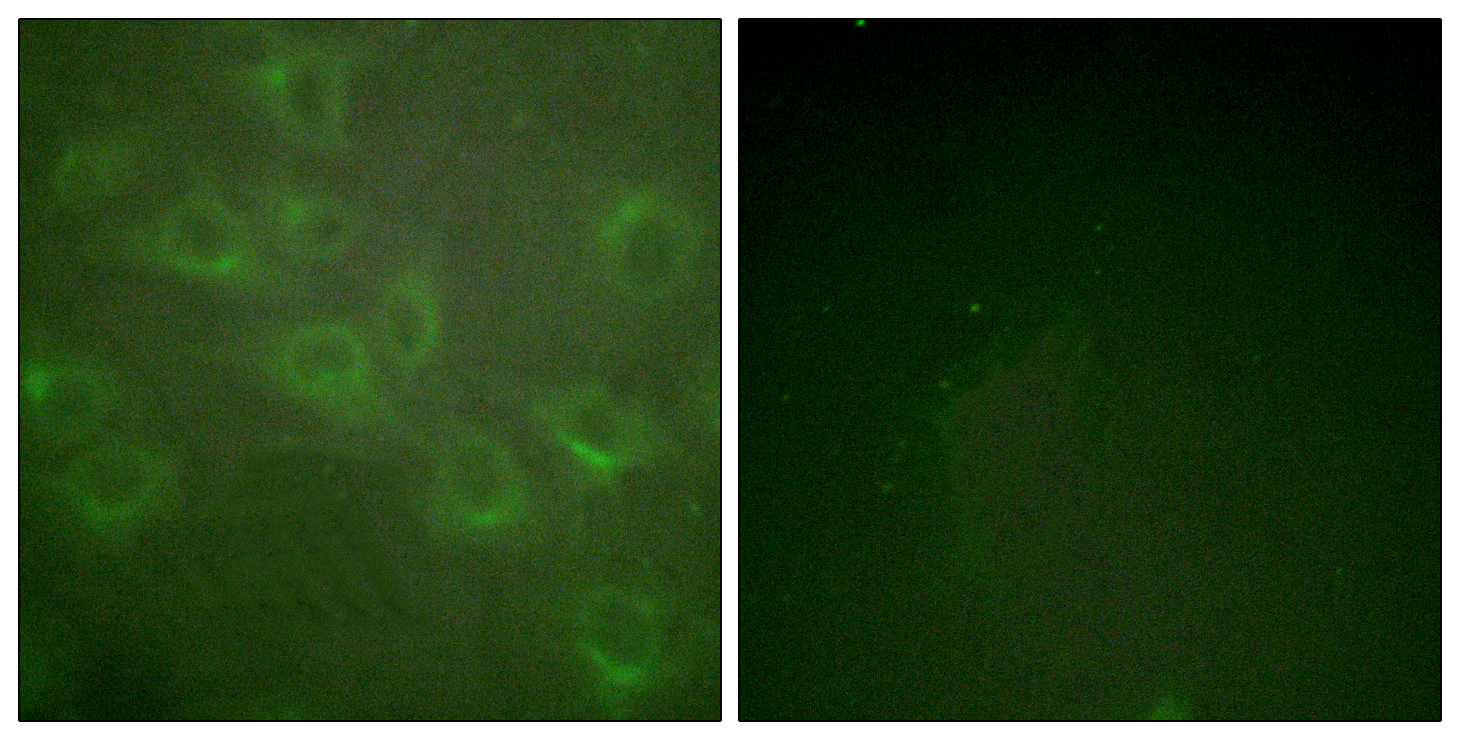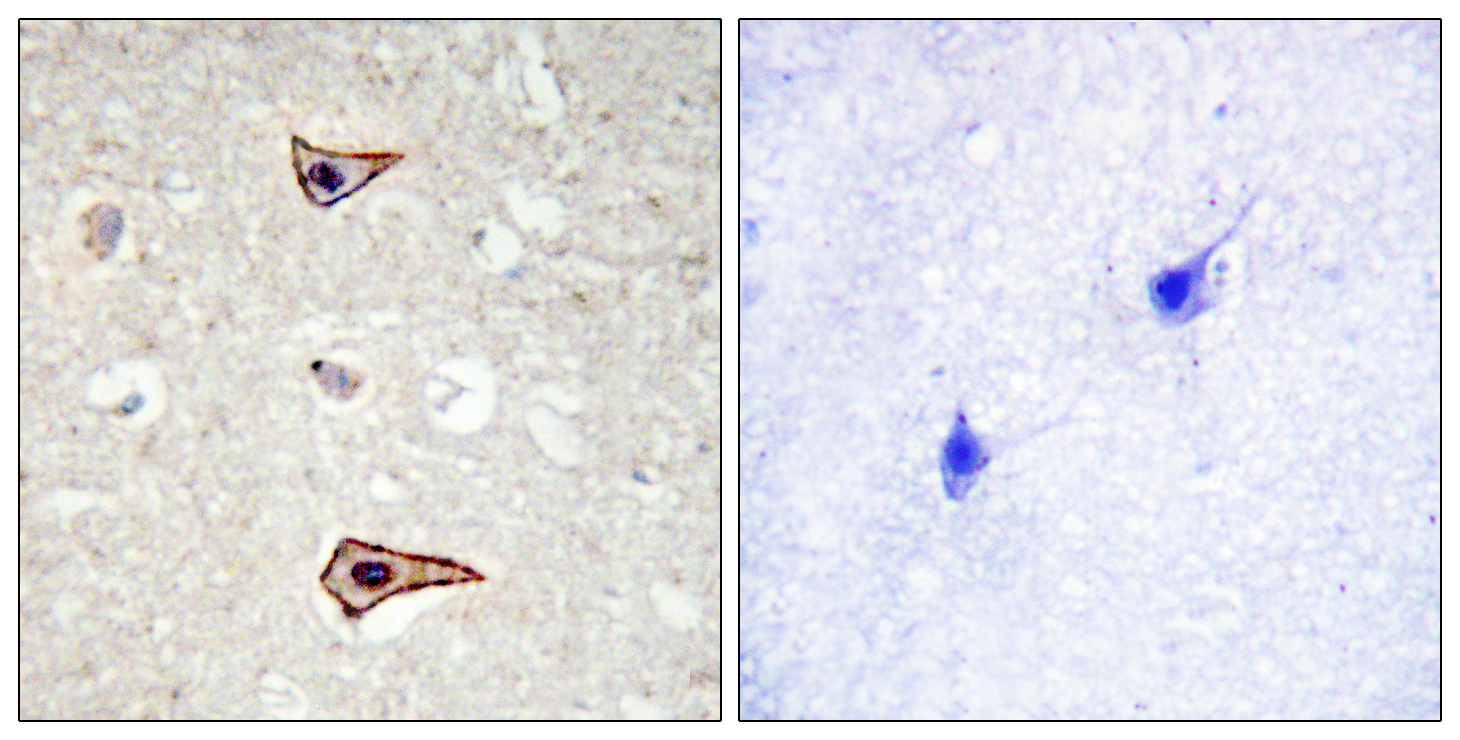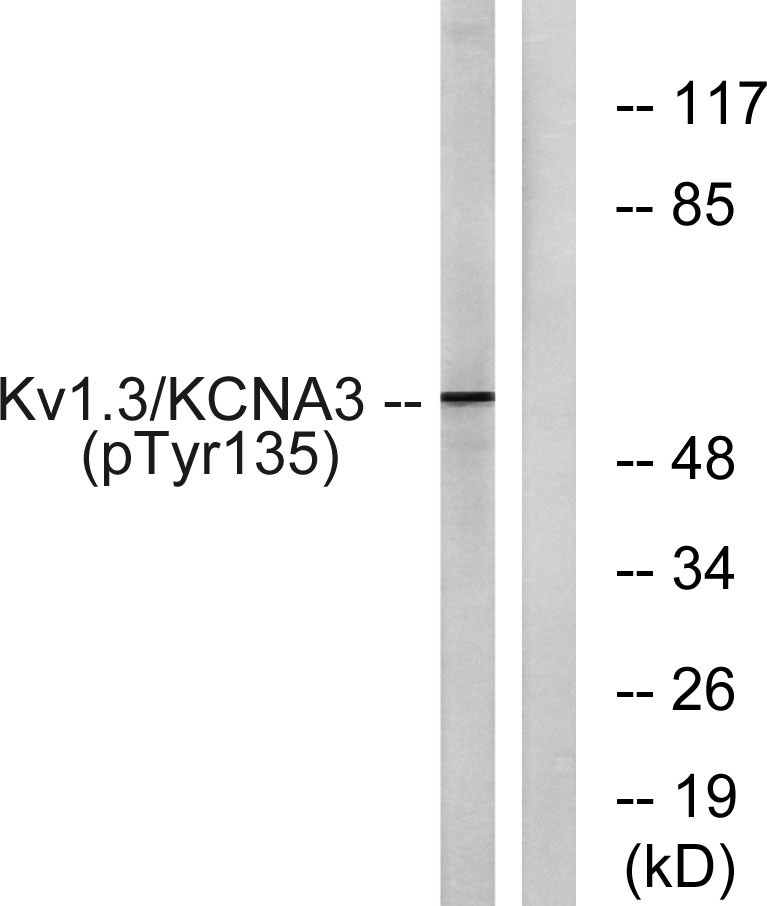Kv1.3 (phospho Tyr187) Polyclonal Antibody
- Catalog No.:YP0939
- Applications:WB;IHC;IF;ELISA
- Reactivity:Human;Mouse;Rat
- Target:
- Kv1.3
- Gene Name:
- KCNA3
- Protein Name:
- Potassium voltage-gated channel subfamily A member 3
- Human Gene Id:
- 3738
- Human Swiss Prot No:
- P22001
- Mouse Gene Id:
- 16491
- Mouse Swiss Prot No:
- P16390
- Rat Gene Id:
- 29731
- Rat Swiss Prot No:
- P15384
- Immunogen:
- The antiserum was produced against synthesized peptide derived from human Kv1.3/KCNA3 around the phosphorylation site of Tyr135. AA range:101-150
- Specificity:
- Phospho-Kv1.3 (Y187) Polyclonal Antibody detects endogenous levels of Kv1.3 protein only when phosphorylated at Y187.
- Formulation:
- Liquid in PBS containing 50% glycerol, 0.5% BSA and 0.02% sodium azide.
- Source:
- Polyclonal, Rabbit,IgG
- Dilution:
- WB 1:500 - 1:2000. IHC 1:100 - 1:300. IF 1:200 - 1:1000. ELISA: 1:20000. Not yet tested in other applications.
- Purification:
- The antibody was affinity-purified from rabbit antiserum by affinity-chromatography using epitope-specific immunogen.
- Concentration:
- 1 mg/ml
- Storage Stability:
- -15°C to -25°C/1 year(Do not lower than -25°C)
- Other Name:
- KCNA3;HGK5;Potassium voltage-gated channel subfamily A member 3;HGK5;HLK3;HPCN3;Voltage-gated K(+) channel HuKIII;Voltage-gated potassium channel subunit Kv1.3
- Observed Band(KD):
- 58kD
- Background:
- Potassium channels represent the most complex class of voltage-gated ion channels from both functional and structural standpoints. Their diverse functions include regulating neurotransmitter release, heart rate, insulin secretion, neuronal excitability, epithelial electrolyte transport, smooth muscle contraction, and cell volume. Four sequence-related potassium channel genes - shaker, shaw, shab, and shal - have been identified in Drosophila, and each has been shown to have human homolog(s). This gene encodes a member of the potassium channel, voltage-gated, shaker-related subfamily. This member contains six membrane-spanning domains with a shaker-type repeat in the fourth segment. It belongs to the delayed rectifier class, members of which allow nerve cells to efficiently repolarize following an action potential. It plays an essential role in T-cell proliferation and
- Function:
- caution:It is uncertain whether Met-1 or Met-53 is the initiator.,domain:The N-terminus may be important in determining the rate of inactivation of the channel while the tail may play a role in modulation of channel activity and/or targeting of the channel to specific subcellular compartments.,domain:The segment S4 is probably the voltage-sensor and is characterized by a series of positively charged amino acids at every third position.,function:Mediates the voltage-dependent potassium ion permeability of excitable membranes. Assuming opened or closed conformations in response to the voltage difference across the membrane, the protein forms a potassium-selective channel through which potassium ions may pass in accordance with their electrochemical gradient.,sequence caution:Translation N-terminally extended.,similarity:Belongs to the potassium channel family. A (Shaker) subfamily.,subunit
- Subcellular Location:
- Cell membrane ; Multi-pass membrane protein.
- Expression:
- Blood,Brain,Lymphocyte,Skeletal muscle,
- June 19-2018
- WESTERN IMMUNOBLOTTING PROTOCOL
- June 19-2018
- IMMUNOHISTOCHEMISTRY-PARAFFIN PROTOCOL
- June 19-2018
- IMMUNOFLUORESCENCE PROTOCOL
- September 08-2020
- FLOW-CYTOMEYRT-PROTOCOL
- May 20-2022
- Cell-Based ELISA│解您多样本WB检测之困扰
- July 13-2018
- CELL-BASED-ELISA-PROTOCOL-FOR-ACETYL-PROTEIN
- July 13-2018
- CELL-BASED-ELISA-PROTOCOL-FOR-PHOSPHO-PROTEIN
- July 13-2018
- Antibody-FAQs
- Products Images

- Enzyme-Linked Immunosorbent Assay (Phospho-ELISA) for Immunogen Phosphopeptide (Phospho-left) and Non-Phosphopeptide (Phospho-right), using Kv1.3/KCNA3 (Phospho-Tyr135) Antibody

- Immunofluorescence analysis of HUVEC cells, using Kv1.3/KCNA3 (Phospho-Tyr135) Antibody. The picture on the right is blocked with the phospho peptide.

- Immunohistochemistry analysis of paraffin-embedded human brain, using Kv1.3/KCNA3 (Phospho-Tyr135) Antibody. The picture on the right is blocked with the phospho peptide.

- Western blot analysis of lysates from Jurkat cells treated with starved 24h, using Kv1.3/KCNA3 (Phospho-Tyr135) Antibody. The lane on the right is blocked with the phospho peptide.



